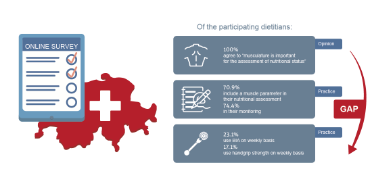ERB and muscle
Muscle parameters are recommended as diagnostic criteria for malnutrition and sarcopenia in various guidelines. However, how are they used by dietitians in Switzerland in their dietetic practice?
Factsheet
- Lead school School of Health Professions
- Institute Nutrition and Dietetics
- Funding organisation Others
- Duration 01.03.2021 - 30.06.2022
- Project management Prof. Dr. Undine Lehmann
- Head of project Prof. Dr. Undine Lehmann
- Project staff Katja Uhlmann
- Partner Abbott AG
- Keywords Dietitian, Nutrition-focused physical exam, Muscle parameter, Muscle strength, Muscle mass, Muscle function, Malnutrition, Sarcopenia
Situation
Muscle parameters are recommended as diagnostic criteria for malnutrition and sarcopenia in various guidelines. However, little is known about the application of muscle parameters in daily practice of nutritional care. The aim of this study was to investigate the current practice of the application of muscle parameters, along with its promoting factors and barriers by dietitians in Switzerland.
Course of action
A 29-item literature-based online survey was developed and distributed via the Swiss professional association of dietitians. The data were analyzed descriptively.
Result
Dietitians (n = 117) from all three language regions completed the survey and were included in the analysis. Musculature was classified as important for the assessment of nutritional status. Body weight (89.7%), handgrip strength (87.2%), bioimpedance analysis (BIA) (87.1%) and Body Mass Index (66.7%) were considered as most significant for evaluation of nutritional status. Seventy-point nine percent (70.9%) of dietitians include at least one muscle parameter in their assessment; BIA was the parameter most often included (73.5%). However, the frequency of use of muscle parameter in daily practice was rather low. Only 23.1% applied BIA on a weekly basis. Lack of knowledge (78.6%), practical experience (71.8%) and lack of equipment (77.8%) were most frequently stated as barriers for usage. The general application of muscle parameters in nutritional care is still lacking. See also publication: https://pubmed.ncbi.nlm.nih.gov/35565723/
Looking ahead
There is an opportunity to further strengthen diagnosis and patient monitoring via a stronger application of muscle parameters in daily practice. Practical training and education could help promote their application.

